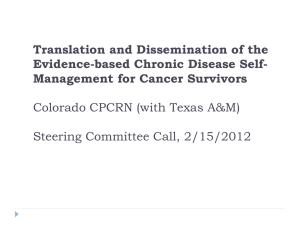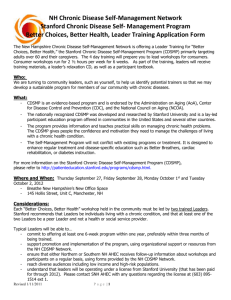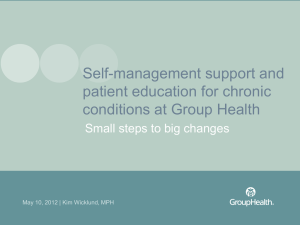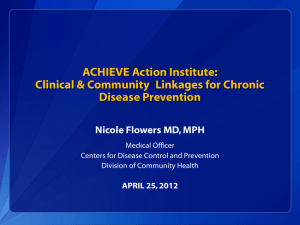Effect of a Self - ACP: Effective Clinical Practice
advertisement
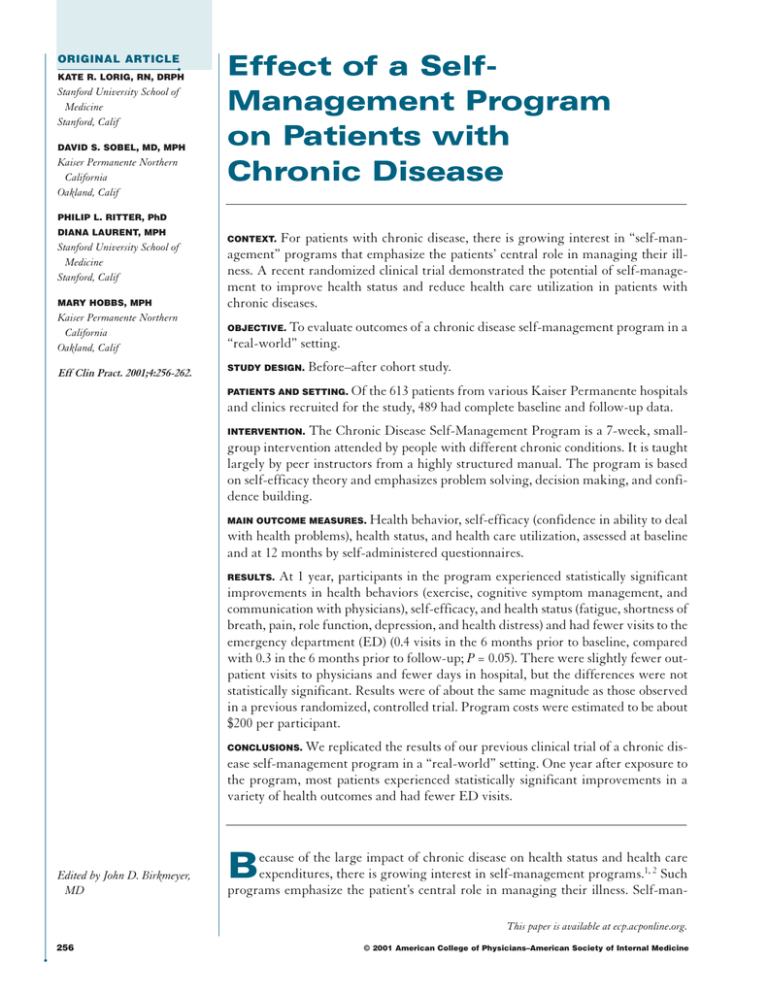
ORIGINAL ARTICLE • KATE R. LORIG, RN, DRPH Stanford University School of Medicine Stanford, Calif DAVID S. SOBEL, MD, MPH Kaiser Permanente Northern California Oakland, Calif Effect of a SelfManagement Program on Patients with Chronic Disease PHILIP L. RITTER, PhD DIANA LAURENT, MPH MARY HOBBS, MPH For patients with chronic disease, there is growing interest in “self-management” programs that emphasize the patients’ central role in managing their illness. A recent randomized clinical trial demonstrated the potential of self-management to improve health status and reduce health care utilization in patients with chronic diseases. Kaiser Permanente Northern California Oakland, Calif OBJECTIVE. To evaluate outcomes of a chronic disease self-management program in a “real-world” setting. Stanford University School of Medicine Stanford, Calif Eff Clin Pract. 2001;4:256-262. CONTEXT. STUDY DESIGN. Before–after cohort study. Of the 613 patients from various Kaiser Permanente hospitals and clinics recruited for the study, 489 had complete baseline and follow-up data. PATIENTS AND SETTING. The Chronic Disease Self-Management Program is a 7-week, smallgroup intervention attended by people with different chronic conditions. It is taught largely by peer instructors from a highly structured manual. The program is based on self-efficacy theory and emphasizes problem solving, decision making, and confidence building. INTERVENTION. MAIN OUTCOME MEASURES. Health behavior, self-efficacy (confidence in ability to deal with health problems), health status, and health care utilization, assessed at baseline and at 12 months by self-administered questionnaires. At 1 year, participants in the program experienced statistically significant improvements in health behaviors (exercise, cognitive symptom management, and communication with physicians), self-efficacy, and health status (fatigue, shortness of breath, pain, role function, depression, and health distress) and had fewer visits to the emergency department (ED) (0.4 visits in the 6 months prior to baseline, compared with 0.3 in the 6 months prior to follow-up; P = 0.05). There were slightly fewer outpatient visits to physicians and fewer days in hospital, but the differences were not statistically significant. Results were of about the same magnitude as those observed in a previous randomized, controlled trial. Program costs were estimated to be about $200 per participant. RESULTS. We replicated the results of our previous clinical trial of a chronic disease self-management program in a “real-world” setting. One year after exposure to the program, most patients experienced statistically significant improvements in a variety of health outcomes and had fewer ED visits. CONCLUSIONS. Edited by John D. Birkmeyer, MD ecause of the large impact of chronic disease on health status and health care expenditures, there is growing interest in self-management programs.1, 2 Such programs emphasize the patient’s central role in managing their illness. Self-man- B This paper is available at ecp.acponline.org. 256 • © 2001 American College of Physicians–American Society of Internal Medicine agement programs aim to help patients with medical management, maintaining life roles, and managing negative emotions, such as fear and depression. In addition, programs provide patients with the necessary knowledge, skills, and confidence (self-efficacy) to deal with disease-related problems. Finally, self-management prepares patients to collaborate with their health care professionals and the health care system. Recently, we documented improved health status and decreased health care utilization in patients randomized to a self-management program called the Chronic Disease Self-Management Program (CDSMP).3 This program consisted of a 17-hour course delivered over 7 weeks to patients with a variety of chronic illnesses. The focus of the course was the day-today self-management of symptoms common to chronic diseases. At 6 months, patients enrolled in CDSMP demonstrated improved health behaviors and health status, as well as fewer visits to the hospital or clinic. Despite the promising results in this trial, however, the effectiveness of self-management has not been evaluated in the context of “real-world” clinical practice. In this paper, we present the 1-year outcomes of an effectiveness study of the CDSMP as implemented by Kaiser Permanente in 1998. Methods Sites In 1997, health education departments from all 11 Kaiser Permanente regions were invited to implement the CDSMP. Nine regions chose to participate in training designed to prepare personnel to teach the CDSMP, to teach others how to teach the program, and to learn how to administer the program in their regions, and six regions participated in the current study. In addition, Group Health Cooperative of Puget Sound formed an affiliation with Kaiser and also participated. Each participating region offered the CDSMP in 1 or more sites, for a total of 21 sites: 8 in Northern California, 6 in Southern California, 1 in North Carolina, 1 in Ohio, 1 in Georgia, 3 in Colorado, and 1 at Group Health Cooperative in Seattle. These 21 sites convened a total of 68 CDSMP classes. The study was approved by the institutional review boards of Stanford University and each participating region of Kaiser Permanente. Participants At each site, patients were recruited to the CDSMP when identified by their physicians or case managers and through announcements in waiting rooms and in health plan newsletters. In one region, letters were sent to high utilizers identified from the automated medical Effective Clinical Practice ■ November/December 2001 Volume 4 Number 6 record. To participate in the program, patients had to be older than 18 years of age, have one or more chronic diseases, and be physically able to attend a seven-session program. When patients arrived for the first session of the CDSMP they were asked to participate in the evaluation of the program. Patients who gave informed consent completed the baseline questionnaire and received follow-up questionnaires by mail at 6 and 12 months. The 13% of patients who did not attend the first session or declined to complete the first questionnaire continued in the CDSMP without participating in the study. Intervention The CDSMP is based on experience with the Arthritis Self-Management Program.4, 5 Each class consisted of 8 to 20 participants of various ages and diagnoses, plus interested family members. Each class was led by a pair of educators who had received 20 hours of training. Fifteen percent of the classes were taught by a pair of professional leaders, 43% by a pair of peer leaders, and 42% by one leader who was a health professional and one who was a peer. Class leaders followed a detailed manual to teach the CDSMP.6 Topics covered in the CDSMP are included in Table 1. The course content has been published in Living a Healthy Life with Chronic Conditions, which served as a reference book for participants.7 The program is based on self-efficacy theory and incorporates skills mastery, reinterpretation of symptoms, modeling, and social persuasion to enhance a sense of personal efficacy (i.e., confidence in one’s ability to manage different aspects of one’s health functioning).8 Self-efficacy has been shown to be a common pathway through which psychosocial programs can affect health outcomes.8 The course includes guided mastery of skills through weekly “action planning” and feedback of progress, modeling of self-management behaviors and problem-solving strategies, and social persuasion through group support and guidance for individual selfmanagement efforts. Outcome Measures Four primary classes of outcomes were assessed: health status, health behaviors, perceived self-efficacy, and health services utilization. All data were collected using self-administered questionnaires. Health Status Measures included self-rated health (using a scale from the National Health Interview Survey),9 disability (a modified version of the Health Assessment Questionnaire disability scale),10, 11 and health distress (a slightly 257 • TA B L E 1 Description of the Chronic Disease Self-Management Program OVERVIEW Number of sessions 7 Length of each session 2.5 hours Number of leaders 2 Mean number of persons per program 9.4 (range 4–18) Mean attendance per person 5.3 sessions TOPICS Overview of self-management and chronic health conditions Making an action plan Relaxation/cognitive symptom management Feedback/problem solving Anger/fear/frustration Fitness/exercise Fatigue management Healthy eating Advance directives Communication Medications Making treatment decisions Depression Informing the health care team Working with health care professionals modified version of the Medical Outcome Study health distress scale).12 The health distress scale assesses the amount of time the patient has been distressed about health (e.g., discouraged, worried, fearful, frustrated by health problems). Illness intrusiveness was measured by using a previously developed index that assesses the impact of disease on multiple aspects of one’s daily life: physical well-being and diet, work and finances, marital stability, sexual and family relations, recreation and social relations, and other aspects of life.13 Shortness of breath, 258 • pain, and fatigue were assessed by using visual numerical scales developed for this study. These scales are based on the more commonly used visual analogue scales,14,15 but differ from the visual analogue scales in that they consist of 10 bars of different heights and different intensity of shading. When the visual analogue pain scale and the visual numerical pain scale were compared (in a population of Spanish-speaking arthritis patients), the correlation was r = 0.72. The 2-week test–retest reliability of the visual numerical version was 0.64.15 Health Behaviors and Self-Efficacy Measures of health behavior and self-efficacy included frequency of exercise, cognitive symptom management, and communication with physician health care providers. These were developed and tested for the original CDSM study and have been described elsewhere.16 Health Services Utilization Four types of health care utilization were assessed: visits to physicians, visits to hospital emergency departments (EDs), number of hospitalizations, and number of nights spent in a hospital. In a previous study, self-reported utilization for all Northern California Kaiser Permanente members (n = 216) who participated in the CDSMP during the last 6 months of 1995 were validated against computerized medical records and medical charts.3 Selfreported outpatient physician visits, including emergency room visits, were well correlated with visits recorded in the computerized medical record (r = 0.70). Patients tended to underreport recorded visits by 17% when compared with the computerized medical records. Conversely, the computer records sometimes had visits recorded that were incorrectly classified. For days in the hospital, medical records data correlated even more highly with patient self-report (r = 0.83). Reporting discrepancies were similar over time, which lessened the concern that reporting errors biased study results.17 It should be noted that for the present study, self-reported data may well be more valid than computerized records, as 33% of the participants reported receiving some of their care outside of Kaiser Permanente. Analysis Paired t-tests were used to assess changes in outcome measures (health status, utilization, health behaviors, and self-efficacy) between baseline and 1 year. We used analysis of covariance to determine if health status and health care utilization outcomes differed among the programs taught by two peer leaders; two professional leaders; or a mixed pair of leaders, one of whom was a peer and the other a professional. These analyses were done by controlling for demographic variables and baseEffective Clinical Practice ■ November/December 2001 Volume 4 Number 6 FIGURE 1. Study patients. CDSMP = Chronic Disease Self-Management Program. 703 patients recruited for CDSMP at 21 sites 90 declined to participate in the study 613 patients completed baseline survey Southern California (n = 234) Northern California (n = 204) Group Health Cooperative (n = 83) Colorado (n = 36) Ohio (n = 21) Georgia (n = 18) North Carolina (n = 17) 124 did not complete follow-up survey 14 died 5 too ill 21 did not finish the course 3 declined to complete the follow-up survey 2 lost to follow-up 79 gave miscellaneous reasons 489 completed follow-up survey at 1 year line status of each outcome variable. Bonferroni corrections were also conducted for this last analysis to account for multiple comparisons. fewer visits to physicians (0.4 fewer; P = 0.19) and fewer days in the hospital (0.5 fewer; P = 0.12). Results During the 1998 calendar year, 68 CDSM programs were offered in seven participating regions to a total of 703 patients (Figure 1). Six hundred thirteen patients (87%) completed the informed consent, attended one or more classes, and completed baseline questionnaires. Eighty percent of the patients (n = 489) completed 1-year questionnaires. There were no significant differences in the noncompletion rate by region. Patient characteristics are summarized in Table 2. At 1 year, there were statistically significant improvements in seven of the nine health status measures: fatigue, shortness of breath, pain, social activity limitation, illness intrusiveness, depression, and health distress (Table 3). However, there were no significant differences from baseline in either self-rated health or disability. Participation in CDSMP was also associated with improvements in all health behaviors (exercise, cognitive symptom management, and improved communications with physicians) and in self-efficacy. There was a statistically significant reduction in the number of visits to EDs (0.1 fewer; P <0.05) and trends toward Effective Clinical Practice ■ November/December 2001 Volume 4 Number 6 TA B L E 2 Baseline Demographic Characteristics of Patients CHARACTERISTICS PATIENTS (n = 613) Mean age, yr 62.2 years Male 27% Education (mean), yr 14.3 years Married 64% Non–Hispanic white 83% Mean number of chronic diseases 2.3 Chronic disease Lung 21% Heart 24% Diabetes 26% Arthritis 42% 259 • We conducted 19 analyses to determine if the status of the leaders (two peer, two professional, and one peer/one professional) affected health behavior, health status, or health care utilization outcomes. After correcting for multiple comparisons, we found no significant differences. Thus, it appears that CDSMP outcomes are the same whether the program is led by peers or professionals. Discussion We found that patient use of CDSMP was associated with better outcomes in all study domains—small but statistically significant improvements in health status, health behavior, and self-efficacy and less use of the ED. In this effectiveness study, participants were not recruited as “study participants,” nor were the programs given in a controlled study environment. Thus, our findings should be indicative of outcomes achievable in a “realworld” health care setting. It is important to acknowledge several limitations in our study. First, given the before–after design, it is possible that the results obtained were not caused by the CDSMP. In fact, our results were similar to those of our previous randomized trial for the nine outcome variables common to both studies.3 A second concern involves dropouts. Approximately 20% of study patients dropped out by 1 year. These patients were younger and TA B L E 3 Changes at 1 Year in Health Status, Health Behaviors, Self-Efficacy, and Health Care Utilization VARIABLE BASELINE MEAN ± SD (n = 489) 12-MONTH CHANGE MEAN ± SD (n = 489) P VALUE Health status* Disability (0–3) 0.4 ± 0.4 0.0 ± 0.3 0.77 Health distress (0–5) 2.3 ± 1.3 –0.3 ± 1.2 ≤ 0.001 Social/role activity limitation (0–4) 2.0 ± 1.1 –0.2 ± 1.0 ≤ 0.001 Illness intrusiveness (1–7) 3.3 ± 1.4 –0.2 ± 1.2 ≤ 0.001 Fatigue (1–10) 5.8 ± 2.5 –0.3 ± 2.4 0.002 Shortness of breath (1–10) 3.3 ± 3.0 –0.3 ± 2.5 0.003 Pain (1–10) 5.2 ± 3.0 –0.3 ± 2.5 0.03 Self-rated health (1–5) 3.3 ± 0.9 0.04 ± 0.8 0.20 Depression (0–3) 1.3 ± 0.6 –0.1 ± 0.5 ≤ 0.001 Health behaviors Aerobic exercise (min/wk) Range-of-motion exercise (min/wk) 87 ± 94.7 13 ± 97.3 35 ± 49.2 9 ± 55.8 0.01 ≤ 0.001 Cognitive symptom management (0–3) 1.3 ± 0.9 0.4 ± 0.9 ≤ 0.001 Communication with physician (0–5)† 2.9 ± 1.2 0.2 ± 1.0 ≤ 0.001 5.2 ± 2.2 0.5 ± 2.4 ≤ 0.001 Physician visits (n, past 6 mo) 5.5 ± 6.0 –0.4 ± 7.2 0.19 Emergency department visits (n, past 6 mo) 0.4 ± 0.9 –0.1 ± 1.0 ≤ 0.05 Hospitalizations (n, past 6 mo) 0.2 ± 0.6 –0.1 ± 0.7 0.14 Days in hospital (past 6 mo) 1.2 ± 5.9 –0.5 ± 7.3 0.12 † Self-efficacy (1–10)† Health care utilization‡ *A lower score is better. † A higher score is better. ‡ Participants were asked to report utilization in the 6 months preceding the follow-up survey. 260 • Effective Clinical Practice ■ November/December 2001 Volume 4 Number 6 more likely to be nonwhite and unmarried (all P <0.05). In addition, the impact of illness on their self-reported health was higher, they had higher activity limitations, and they made more doctor and ED visits at baseline (all P <0.05). For these reasons, we repeated our analyses, carrying forward the last data collected, either baseline or 6 months. The only difference between this and the original analysis was that the trend toward fewer visits to physicians was stronger (P = 0.08). Finally, as in all studies involving human patients, these participants were volunteers. Thus, the effects of this intervention can only be extrapolated to patients willing to take part in a 7-week group intervention. We have several indications that this may be a sizable percentage of the population with chronic illnesses. Glasgow and Toobert18 found that 40% of the diabetics in a group practice, when asked to participate, took part in a diabetes education program. Initially, most recruitment for the present study was centered on securing referrals from health professionals. More recently, recruiting for the CDSMP within Kaiser Permanente has been done largely through letters to panels of patients with targeted diseases. The acceptance rate with a single letter has been 5% to 10%. Implementation of CDSMP may substantially reduce health care costs. Over the 1-year period, study participants had a mean of 0.97-day reduction in hospitalization (P = 0.08). This includes –0.45 days change in the first 6 months (data not shown in tables), plus –0.52 in the second 6 months (Table 3). They also averaged 0.2 fewer ED visits (P = 0.01) (–0.11 in the first 6 months plus –0.09 in the second 6 months). Taking $1000 as an average cost per hospital day and $100 for the average cost of an ED visit, the expected savings would be $990 per participant in the first year. The cost of the intervention within the Kaiser Permanente system (including leaders’ training, materials, and administration) is approximately $200 per participant. If these changes are real, the savings for the 489 patients who completed the study were nearly $400,000, or a 1:4 cost-to-savings ratio. This suggests that the program may more than pay for itself. With growing recognition of the effectiveness of CDSMP, enrollment in the program in Kaiser Permanente had increased to 2500 participants in the year 2000. Further expansion of the program appears to be limited as much by system capacity (e.g., group leaders, space, scheduling) as by patient interest. Because most patient education interventions are disease-specific, it takes additional time and effort to recruit patients to our more generic program. However, we believe that the benefits likely to be achieved by self-management Effective Clinical Practice ■ November/December 2001 Volume 4 Number 6 Take-Home Points • For patients with chronic disease, there is growing interest in “self-management” programs, which emphasize the patients’ central role in managing their illness. • Although a randomized clinical trial has suggested the efficacy of self-management, we sought to examine the effectiveness of such programs in actual practice. • We reported the effects of a Chronic Disease SelfManagement Program on health status and resource use in 489 managed care patients. • Patients enrolled in the self-management program experienced small but statistically significant improvements in health status, health behaviors, and self-efficacy. In addition, patient use of the program was associated with fewer emergency department visits. • Because both efficacy trials and “real-world” studies suggest their effectiveness, health systems should consider implementing self-management programs for patients with chronic conditions. justify the energy and resources required to implement the programs. References 1. Rothenberg RB, Koplan JP. Chronic disease in the 1990s. Annu Rev Public Health 1990;11:267-96. 2. Hoffman C, Rice D, Sung H-Y. Persons with chronic conditions: their prevalence and costs. JAMA 1996;276:1473-9. 3. Lorig KR, Sobel DS, Stewart AL, et al. Evidence suggesting that a chronic disease self-management program can improve health status while reducing hospitalization. A randomized trial. Med Care 1999;37:5-14. 4. Lorig K, Lubeck D, Kraines R, Seleznick M, Holman H. Outcomes of self-help education for patients with arthritis. Arthritis Rheum. 1985;28:680-5. 5. Lorig K, Mazonson P, Holman H. Evidence suggesting that health education for self-management in patients with chronic arthritis has sustained health benefits while reducing health care costs. Arthritis Rheum. 1993;36:439-46. 6. Lorig K, González V, Laurent D. The Chronic Disease SelfManagement Workshop Leaders’ Manual (revised). Stanford, CA: Stanford Patient Education Research Center, Stanford University; 1999. 7. Lorig K, Holman H, Sobel D, Laurent D, González V, Minor M. Living a Healthy Life with Chronic Conditions. 2nd ed. Palo Alto, CA: Bull Publishing; 2000. 8. Bandura A. Self-Efficacy: The Exercise of Control. New York: WH Freeman; 1997. 9. U.S. Department of Commerce. National Health Interview Survey. Hyattsville, MD: U.S. Dept of Health and Human Services; 1985. 10. Fries J, Spitz P, Kraines R, Holman H. Measurement of patient outcome in arthritis. Arthritis Rheum 1980;23:137-45. 261 • 11. Ramey D, Raynauld J, Bries J. The health assessment questionnaire 1992: status and review. Arthritis Care Res. 1992;5:119-29. 12. Stewart BJ, Hays RD, Ware JE. Health perceptions, energy/fatigue, and health distress measures. In: Stewart AL, Ware JE, eds. Measuring Functioning and Well-Being: The Medical Outcomes Study Approach. Durham, NC: Duke University Pr; 1992. 13. Devins G, Mandin H, Hons R, et al. Illness intrusiveness and quality of life in end-stage renal disease: comparison and stability across treatment modalities. Health Psychol 1990; 9:117-42. 14. Downie W, Latham P, Rhind V, Wright V, Branco J, Anderson J. Studies with pain rating scales. Ann Rheum Dis. 1978;37: 378-81. 15. González V, Stewart A, Ritter P, Lorig K. Translation and validation of arthritis outcome measures into Spanish. Arthritis Rheum. 1995;38:1429-46. 16. Lorig K, Stewart A, Ritter P, González V, Laurent D, Lynch J. Outcome measures for health education and other health care interventions. Thousand Oaks, CA: Sage Publications; 1996. 262 • 17. Ritter P, Lorig K, Stewart A, Sobel D, Bloch D. Self-reports of health care utilization compared to provider records. J Clin Epidemiol. 2001;54:136-41. 18. Glasgow RE, Toobert DJ. Brief computer assisted diabetes dietary self-management: effects on behavior, physiologic outcomes and quality of life. Med. Care 2000; revision submitted. Acknowledgment The authors would like to acknowledge the assistance of Jayna Rogers, Teresa Baylon, Virginia González, the Kaiser Permanente regional health education directors, regional project coordinators, site coordinators, trainers, and leaders. Further information is available on the website: www.stanford.edu/group/perc/. Grant Support This project was supported in whole or in part by the Kaiser Foundation Research Institute and the Garfield Memorial Fund. Correspondence Kate R. Lorig, DrPH, Stanford Patient Education Center, 1000 Welch Rd., Suite 204, Palo Alto, CA 94304; telephone: 650-7237935; fax: 650-725-9422; e-mail: lorig@stanford.edu. Effective Clinical Practice ■ November/December 2001 Volume 4 Number 6
